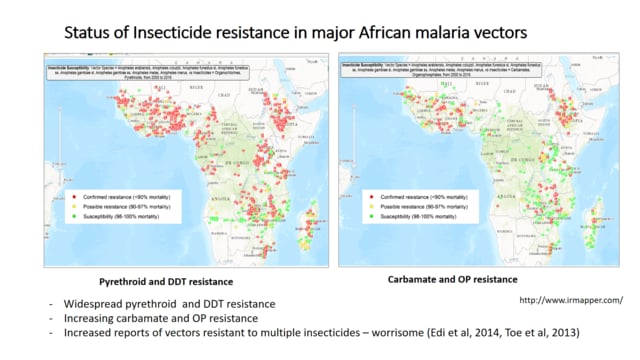ASTMH 2016, Corine Ngufor: “Comparing the efficacy of insecticide mixture and combination strategies for improved control and management of pyrethroid resistant malaria vectors in southern Benin, West Africa”
Countries: Benin
Published: 14/11/2016
In collaboration with ASTMH, Image Audiovisuals, and session presenters, MESA brings you this webcast from the 65th ASTMH annual meeting in Atlanta, November 2016.
Title: “Comparing the efficacy of insecticide mixture and combination strategies for improved control and management of pyrethroid resistant malaria vectors in southern Benin, West Africa”
Speaker: Corine Ngufor, LSHTM
Session information: Scientific Session 12: “Mosquitoes: Operational Control”
Monday, 14 November, 8am – 9:45 am, Marriott – Room A703/704
Abstract:
The Global Plan for Insecticide Resistance Management (GPIRM) recommends the use of a combination/mixture of unrelated insecticides against insecticide resistant malaria vectors for improving control and managing resistance. This concept can be applied by using insecticide mixtures on mosquito bed nets, co-formulated insecticide mixtures for indoor residual spraying (IRS) or deploying non-pyrethroid IRS together with pyrethroid bed nets. The uptake of these strategies at national levels has been slow due to lack of effective new mixture/combination tools and insufficient evidence on efficacy to guide decision making. Mixtures on bed nets or IRS being single interventions could be cost effective and more desirable than the combined intervention approach if comparable levels of impact can be demonstrated in terms of their ability to improve vector control and manage resistance. The current study compared the efficacy of a newly developed chlorfenapyr (a pyrolle) and alphacypermethrin (a pyrethroid) mixture long-lasting bed net (Interceptor G2) to an IRS mixture of chlorfenapyr and alphacypermethrin and a combined chlorfenapyr IRS and alphacyperthrin long-lasting net (Interceptor 1) intervention in experimental huts against wild pyrethroid resistant malaria vectors in Cove, Benin. Mortality rates were very low with alphacypermethrin IRS alone (5%) and Interceptor 1 alone (24%) owing to high levels of pyrethroid resistance in the vector population. Mortality with the mixture IRS (42%) was unexpectedly lower than IRS with chlorfenapyr alone (51%) (P<0.005). The mixture net (Interceptor G2) and the combined IRS and bed net approach provided the highest mortality rates and these were similar between both treatments (75% vs. 69% respectively, P>0.05). Blood feeding rates were also significantly reduced with these treatments compared to the control and the mixture IRS (P>0.05). The results demonstrate that Interceptor G2 could be a more cost-effective and reliable strategy for improving the control of pyrethroid resistant malaria vectors and managing resistance compared to the combined intervention approach and the mixture IRS.



